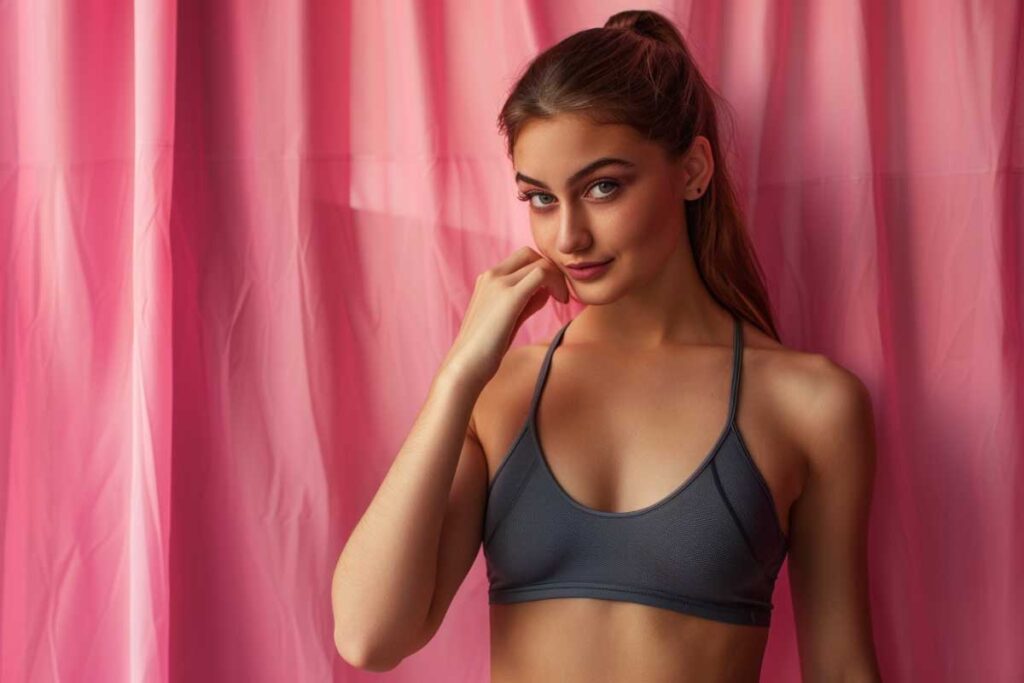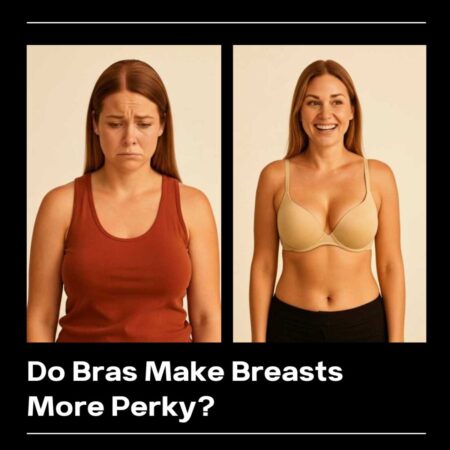Finding a bra that fits just right can feel impossible sometimes. But being in the wrong size or style isn’t just uncomfortable – it can lead to back, neck, and shoulder pain, skin irritation, and poor posture over time.
Luckily, there are a few simple tricks to determine whether your bras are offering proper support and coverage or need to be replaced. In this article, we’ll go over the telltale signs of ill-fitting bras, plus tips from experts on how to measure yourself and identify the best types and brands for your body. With the right fit knowledge, you can upgrade your underwear drawer and enjoy the comfort and confidence you deserve.
How to tell if your bra fits
Getting a good fit from your bra really matters, and it can be a little tricky. Whether you’re working with a bra fitter, bra shopping online, or you’ve measured yourself for your bra size, knowing the basics of how your bra should fit and what to look for in a well fitting bra is important. You’ll always feel your best when wearing a bra that fits!
Take some time to explore the six fit tips below.
Get a bra from your drawer, stand in front of a mirror, and put it to the test. Find out for certain: does your bra really fit?
1. Band
The band of your bra is very important. In fact, it’s responsible for the majority of your bra’s support. It acts as an anchor, to hold your bra in place. Start here when you have issues like slipping bra straps, digging underwires, or gaping cups. Surprisingly, these problems can often be solved by adjusting or updating the band.
What to look for in the mirror:
- Your bra band should fit nice and snug around your torso. The band should not easily pull away from your body, either in the front or the back.
- The band should sit straight and parallel to the floor. It should start with the underwires or top portion of the band sitting directly underneath the bust, at the breast root, and go directly back.
- It’s totally normal if you have a little overhang or “back fat”. Elastic is wrapping around your body, and no one is made of metal or steel. Often, a wider bra band will lay flatter and can smooth out this issue.
Tips:
- If your band is riding up, gaping, or not staying in place, it’s most likely too big or stretched out. Keep in mind that washing and drying your bra properly will help it last longer.
- Because bra bands are typically made with elastic, they will stretch out over time. That’s why, when purchasing a new bra, it’s wise to start with the hooks placed on the loosest hook. If it fits snugly on that hook, you can move the hooks in to the second setting as it stretches, and the third as it stretches again.
- If the band is too tight, try a band size up, keeping in mind that you’ll need to adjust the cup size accordingly.
- If your band clasps in the front, the same rules apply, except there’s only one hook option.
- If your bra is put on over the head and there are no hooks, it should still fit nice and snug around your torso.
2. Center Gore
Now that the band fits, it’s time to look at the front of our bra. Located at the “center gore”. This is the part of the bra that attaches the two front cups together. Usually, if it’s an underwire bra, this is where the wires, band, and cups all connect. Getting the right fit here is key to a great fit.
What to look for in the mirror:
- The center gore should, with the help of the snug band, lay flat, in between your breasts, against your body. This is called “tacking”. If it fits well against your body, that means it “tacks” against your body.
- You should not be able to easily pull it away from your body or fit your hand in between the center gore (or band of the bra) and your body.
Tips:
- Keep in mind that a center gore can be wide, tall, narrow, etc. And it can be made of many materials, including stretch or firm, elastic or woven. Depending on the shape and the material, some bras are designed for a firmer or looser tack.
- Because of their shape, the center gore of some minimizer bras are not designed to tack as much as other bras.
- The center gore of bras with an underwire will tack in place much more than a bra without an underwire.
- Even though they won’t tack as well as an underwire bra, it’s still important that your wire-free bras fit snug and firm so they can stay in place.
- If the center gore does not tack, the most common issues are the cup is too small or that the band is too loose. Adjust as necessary.
3. Underwire
If you’re wearing an underwire bra, it’s important to make sure it fits well and is placed correctly. Many women who find underwires uncomfortable are simply in the wrong size bra, or have not assessed the fit of their bra. With a little attention to the fit, you can wear the support of an underwire bra and feel very comfortable. Of course, if you prefer, you can also wear a wire-free bra.
What to look for in the mirror:
- Your underwire should fit directly around each breast tissue. Make sure that it is not sitting below or on your breast.
- The underwire should fit flush with your body, including the center gore, with the entire breast inside.
Tips:
- Breasts have a tendency to want to go side to side. If the side of your underwire is on your breast, scoop the breast tissue forward as you pull the wire back. This will place the breast inside the wire, and the wire on your body, behind the breast tissue.
- If your breasts do not fit into the underwire so that it can comfortably sit flush on your body, it is too small, or too narrow for your cup size.
- If wearing a wire-free bra, it’s still important to make sure your breast is forward and inside the cup area of the bra.
4. Cups
Now that you’ve checked the band, the center gore, and the underwire, it’s time to check out the fit of the cups. Finding, assessing, and adjusting your cup size takes some trial and error and some basic knowledge. No matter what the letter says, you’ll need to know how to tell that it fits well.
What to look for in the mirror:
- After adjusting the band, and all of your breast tissue inside the underwire, there should be no gaping or spilling of the cups. Your breasts should fill up the cups perfectly.
- Check where the top of the cup stops and your bust or chest begins. Whether it’s a molded bra or not, the cup should lay flush with your body.
Tips:
- If your breasts are uneven, fit your bra to the fuller bust and leave a little room on the smaller side. You can then fill up the smaller side with an insert, or a removable push up pad.
- If you are spilling out of the cup, you can either try a cup size up, or a full-coverage bra. Sometimes, a change in style is better than adjusting the size.
- If your cups are gaping and have too much room, you can either try a cup size down, or try a style with less coverage, like a plunge, demi, or push up bra.
- Keep in mind that cup sizes vary by country, so take note of different sizing methods when adjusting your cup size.
5. Straps
Did you know that your straps are not responsible for the majority of your bra’s support? That’s right! Their primary function is to keep the cup flush against your body, or from falling away. But it’s the snug band that actually keeps your bra up and in place. That being said, your bra straps still serve an important function.
What to look for in the mirror:
- Your bra straps should stay in place, snugly but comfortably in place, keeping your bra cup flush against your bust.
- Most bra straps are made of elastic. Depending on the strength of this elastic, a good rule of thumb is that you should be able to lift them about 1″ off of your shoulders with some mild force.
Tips:
- If you can easily lift your bra straps more than 1″ off of your shoulder, or up to your ear, they are too loose. Adjust them shorter to fit better.
- If your straps are always falling down, check the bra band first. If it’s too loose and is riding up, it will cause the straps to fall. Start with as secure anchor first!
- If your straps are still falling down after you’ve checked the band and adjusted the straps, consider trying a style that either places the straps further in on the back band, or is convertible or has a racerback option.
- If your straps are digging, you should also check the band for a good fit first. If the band fits well and they still dig in, try a wider strap, a strap with a built-in cushion, or add a soft silicone cushion that can attach to any bra strap.
6. Look and Feel
The most important part of a good fit: how does it look and feel? Even if a bra is the correct size, a great style, or made by a reputable company, it has to feel comfortable enough to wear and give you the look or shape that you love.
What to look for in the mirror:
- Take a real look at yourself in the mirror and make sure you love the style of the bra, and the shape it gives you.
- Use a white t-shirt to test a neutral color, or a typical blouse that you’ll wear with this kind of bra to test out the shape. If the bra is for a special occasion, try it with the dress or outfit you want to wear it with to make sure it’s a great match.
- Move around a little and make sure that everything feels great!
Tips:
- There are thousands and thousands of bra options out there. Don’t settle for something that doesn’t fit well and feel great.
Why Fit Matters
Bras aren’t just elastic and wires – they can lift more than just your bust. I’ve seen firsthand how the right fit can boost posture, ease pain, and lift spirits. If you think fit doesn’t matter, I urge you to reconsider.
When bras don’t fit right, they poke, pinch and irritate. Underwires dig, straps slip, and bands squeeze. This causes daily discomfort and bigger problems like poor posture and low confidence.
It’s often not the bra itself, but the fit. Like shoes that don’t support your feet, ill-fitting bras strain your body.
The solution is simple: Find a bra that fits properly. This eliminates pain so you can breathe and focus easier.
How to Find Your Best Fit
Measuring yourself or seeing a fitter gives your size starting point. Learn what the numbers mean and how band and cup relate. Different sizes may fit depending on brand and style. Educating yourself gets you closer to comfort.
Beyond Just Comfort
A well-fitted bra does more than lift and support. It creates an ease and lightness, literally and figuratively. You stand taller and more open. I’ve seen it lift women’s spirits and transform how they see themselves.
The mirror after putting on a bra that finally fits right reveals a new you.
Wearing a bra isn’t mandatory. But if you do, find one that makes you feel great. With the right fit, bras can be powerful.
More resources:
- Celebrities and the Candid Braless Trend: A Candid Look at Fashion and Photography
- What Lingerie is Best for My Shy Girlfriend
- What’s Your Lingerie Personality?






